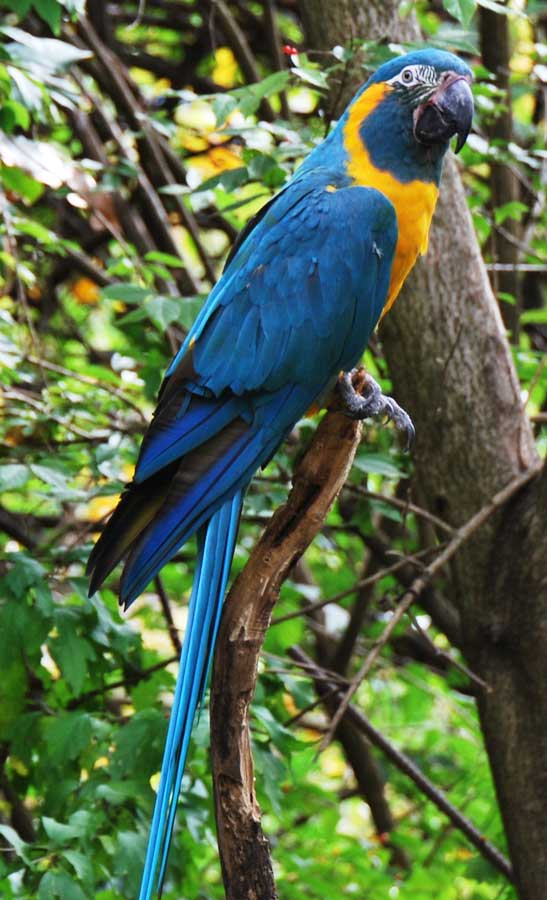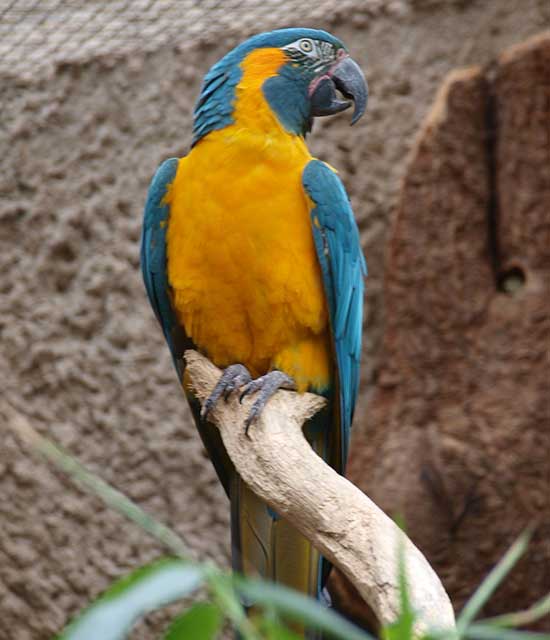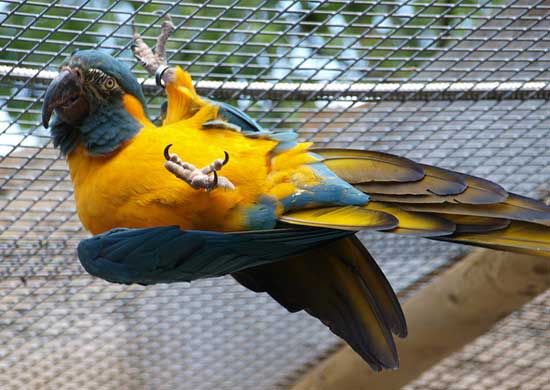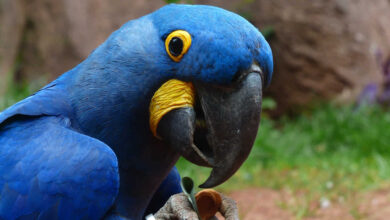Blue Throated Macaw ( Ara Glaucogularis )
About Blue Throated Macaw
The Blue Throated Macaw in generous Ara of large long-tailed parrots jointly known as a macaw. Ara glaucogularis (reclaimed 26 February 2014) or Ara caninde are well known as a caninde macaw or Wagler’s Macaw (is in honor of German herpetologist Johann Georg Walger ).
The Blue-throated is observed in a small area of north-central Bolivia that is known as Los Llanos de Moxos and in 2014 assigned by law as a regular patrimony of Bolivia, where it is acknowledged as Barba Azul means ‘blue beard’ in Spanish.
The rank of blue-throated is approximately 350-400 individual surviving in the wild and its primary cause of downfall to using in the pet trade. The glaucogularis has become a critically endangered (a species is in the high risk of extinction in the wild) and is protecting by trading prohibitions.
Table of Contents

Scientific Classification
| Kingdom | Animalia |
| Phylum | Chordata |
| Class | Aves |
| Order | Psittaciformes |
| Family | Psittacidae |
| Genus | Ara |
| Species | Glaucogularis |
Characteristics
The blue-throated macaw is almost 85 cm long with tail feathers and wingspan nearly 3 feet or 0.9 m. The macaw has 900 g weighs and males have a tendency to be larger than females with the masses of 750 g and 950 g in that order.
The body of blue-throated macaw is in the combination of two colors blue and yellow as upperparts are turquoise-blue, lightly duller crown and brighter on the back. Under part is yellow with pale blue vent.
There is a thinly feathered spot of skin near the base of the large dark-colored skin that has 5 or 6 parallel streaks of blue feathers that make unique of every blue throated macaw and can use to independently distinguish adults.
The adults blue-throated macaw have yellow irises, and infantile with brown irises. Snuggle’s eye color initially changes black to brown as eyes open.
The eye color of macaw will modify white at the age of 1 to 3 years while a mature macaw’s iris turns yellow and the mass of golden gains with the age after 10 years.
Dwelling
The blue throated macaw is one of the rarest macaw species in the world, and inhabit on two areas northwest and south Trinidad (The capital city Bini). This landscape includes of marshes, Forest Island, grassland, and passages of forest along waterways. This species is not a forest-dwelling bird. They frequently found between the elevations of 200 to 300 m.
Deeds
This parrot most found in monogamous pairs, in a small group 7-9, and can join flocks approximately 70 in big roosting groups. The main mode of locomotion is flying but can tricks along branches, climb trees, and walk on the ground.
They are very intelligent and easy to train. Blue throated macaw is very adjustable and can make wonderful pets because they have a propensity to become chilly.

Nesting
Blue-throated macaw makes their nests in the pits of palm trees and most often Attalea phalerata, just like hyacinth macaw, yet will make a nest in other palm species as well. Dead palm is an ideal place for nesting because they are hollowed out by large grubs after dying.
The pairs of blue-throated macaw do not stay consistently at one place for consecutive breeding and they switch to different nesting sites every year.
In the wild, blue-throated macaws have to compete for nesting holes with others species like a blue-and-yellow macaw, a green-winged macaw, scarlet macaw, large woodpeckers, toco toucans, barn owls, bats, and bees. Due to land clearing in its range, the number of ideal nesting tree has reduced.
Vocalization
Their lookout or alarm calls define as loud and sharp slightly higher pitched than those of the related Blue-and-gold Macaw. When they disturbed, flocks of them lift off into the air screaming loudly and circling aloft continuously, even they feel the danger has passed.
The blue-throated macaws generally stay in one area during the day and communicate with each other with quite caws as well.
Feeding
The seed and nuts of blue-throated macaw are not favorite food with the same extent as other species do. They eat primarily food from large palms species like Attalea phalerata and most important natural dispersal agent as carrying the seeds in different places for new growth.
They eat the mesocarp from ripe fruits and have observed drinking the liquid from young plants.
Breeding
The blue-throated macaws are monogamous forming pair bonds that last a lifetime and usually, they breed once a year. However, in the cast of losing of eggs and nesting, they may reproduce the second clutch in the same season.
The average clutch consists of 2-3 eggs and incubation period of eggs is about 29 days. Both parents protect and feed the young one that fledges when they are about 4 months old.
Anyway, they remain with their parents for one year and reach on a productive stage as they are about to 5 years old.

Status
It is estimated that about 50-249 of these radiant parrots survive in the wild. The main cause is habitat destruction and pet trading. They heavily rely for food and nesting on the Motacú palms (Attalea phalerata) – trees. Unfortunately, the locals are taking great benefit from these trees like construction, food, medicine, cosmetic, and edible oil. Most unluckily, these trees are burnt for agriculture and grazing purpose.
Pet trade has stopped their races at some extent, but this species easily breed to captivity. They are still rare and expensive to acquire and can cost 2000$. The captive blue-throated birds are appreciated for their playfulness, intelligence, and inquisitive nature.
They have the ability to mimic human vocalization and can live 50 years or longer.
Diseases and Disorders
A pet macaw will seldom become ill, but something in the environment can cause illness and catch few diseases in the blue-throated macaw.
Visible Sign of Illness
Here is the list of some visible sign of illness in this Species.
- Ruffled plumage
- Lethargy
- Drooping wings
- Weakening body
- Extreme mood changes
- Having no appetite
- Swelling in feathering
- Partially closed or watery eyes
- Bulging of the eyelids
- Rasping
- Trouble breathing
- Unnecessary saliva
- Dirty vent
- Any change in the excretions not apparently to diet related.
Common Illness
Some common illness list is below here.
- Proventricular Dilation disease (Macaw wasting disease)
- Psittacosis (chlamydiosis or parrot fever)
- Bacterial, viral, or fungal diseases
- Feather culling – results of boredom, poor diet, sexual frustration, and absence of bathing
- Hypersensitivities
- Chewing flight and tail feathers by juveniles
- Beak abnormalities in chicks
- Papillomas
- Kidney disease (gout)
- Toxicity – heavy metal poisoning
- Lipomas in mature birds
FAQS:
Major cause of extinction is habitat destruction and pet trading.
They do not like the food like seeds and nuts, but they depend for food large palms species like Attalea phalerata.
The blue throated macaw rely for food and nesting on the Motacú palms (Attalea phalerata) – trees.
In captivity, they are able to breed for about 30-35 years and few go long for 50 years. Although the information about blue throated macaw has not discovered in wild properly, because this species retrieved 2014.
This species is very intelligent and do some incredible acts to get the attraction.
The blue-throated macaw is very entertainer, eye-catching bird, and easy to train.
These are quite small in length as compared to blue and gold macaw. They belong to same family macaw and this blue-throated species have recently discovered in 2014.
Some blue throated can speak, and the majority macaw has not the capability to mimic.
Yes, it is against the law to transport them across state lines without allowed.
